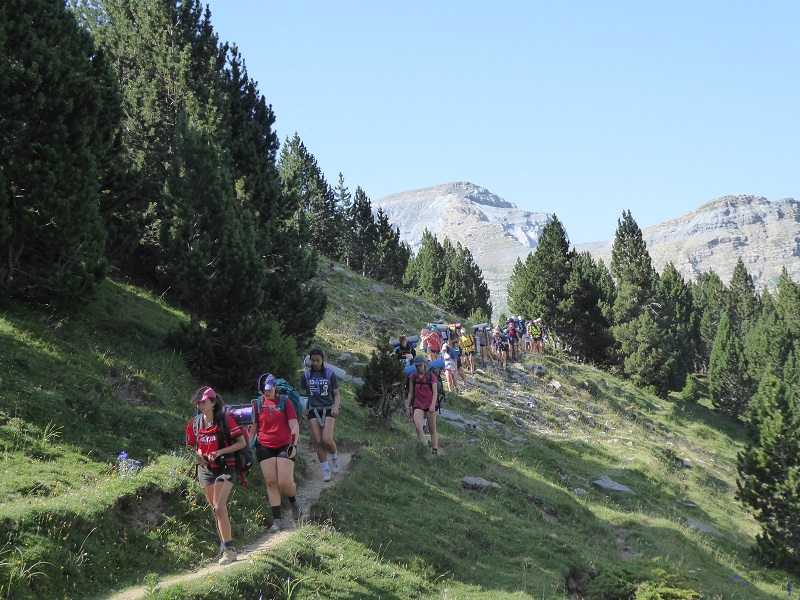
Last year in the Pyrenees, after a couple of hours walking west from Bujaruelo along the GR11 we came across a large – 50 plus – group of young people packing up camp after a night of very heavy rain. I was struck at the time that you would be very unlikely to see such a sight in Scotland. This year, on the Spanish side, we came across three large groups of young people who had been camping in wild places up in the mountains.
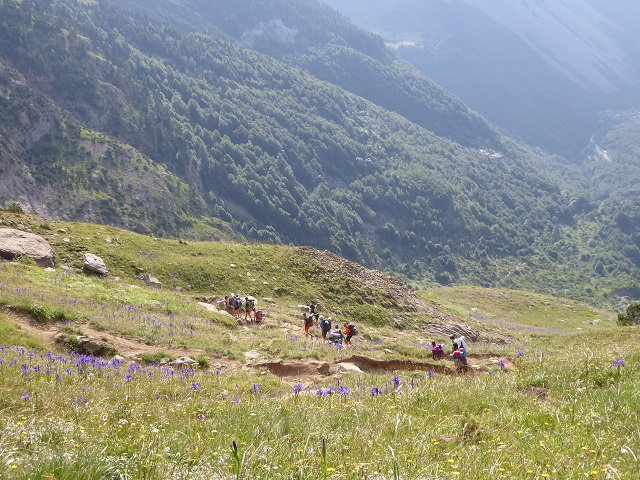
In Scotland, I don’t think this could never happen because of concerns about safety. Added to this there are all the vested interests who, for whatever reason, want to keep wild land to themselves. They would argue such large groups are an affront to the wild land experience, disturb wild land and do all sorts of damage to the natural environment.
Its true, as we passed the group of Young People in the first photo, the birds did disappear temporarily but the sound of bird song was replaced by human singing. The Young People appeared to be having a good time and there was no sign of uniforms to suggest they were part of some neo-fascist youth movement!
I was impressed. Two of the three groups we saw had had to carry their camping kit up over 3,000 ft, equivalent to backpacking up a Munro from sea-level and camping on the summit. Not that many people do that in Scotland. Maybe that’s because they don’t get the experience of doing so when they are young?
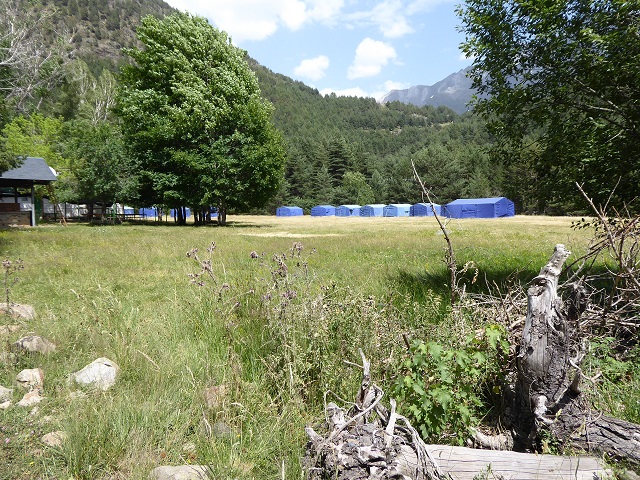
The base for these expeditions appear to be temporary camps set up in the mountains – we saw two such camps. At the Viados Hut, not far above the camp in the photo above, we came across the smallest group, this time of primary age children, lounging under a tree outside the hut. My partner, who is a primary teacher, immediately observed they were remarkably quiet and we realised they were having a siesta in the heat of the day. There was a higher ratio of young adults than in the other groups, but most appeared around 20. In the early evening the group disappeared off up the hill.
In none of these cases did we find any traces of the overnight camps
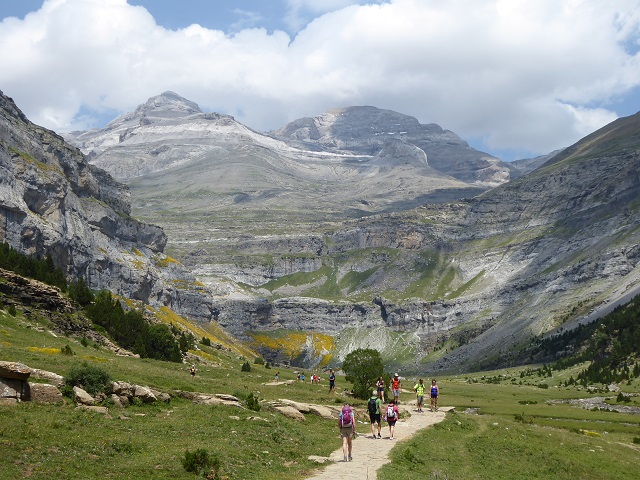
Another thing that struck me in the Ordesa National Park was the number and diversity of people walking up to the Cola de Cabado (pony tail) waterfalls at the head of the canyon in the heat of the day. There were 100s. Its a ten mile round trip, with around 400m of ascent and takes at least 4 hours. The nearest equivalent we have is probably people walking up Ben Nevis or maybe Ben Lomond.
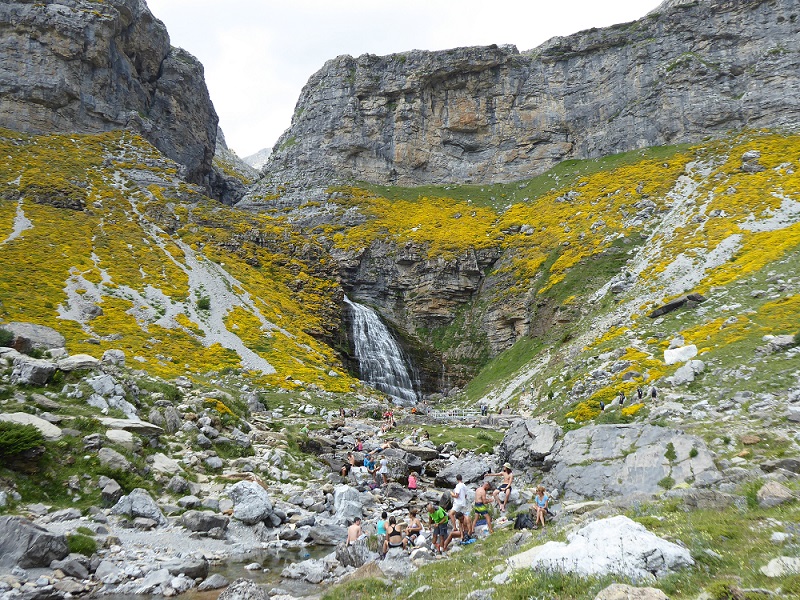
You could view the sheer number of visitors as destroying the experience but then how do you select the people who should be allowed to go? My response was rather different, isn’t it amazing that so many people are prepared to walk so far? I wondered whether this willingness to walk is somehow connected to those mass expeditions of young people
The contrast between what is happening on the ground in the Ordesa Monte Perdido National Park and the Loch Lomond and Trossachs National Park is striking. In the Lomond and Trossachs most of the outdoor centres have been closed due to austerity, while the camping byelaws have turned youth expeditions into an exercise in bureaucracy rather than enjoyment. As a result, people vote with their feet.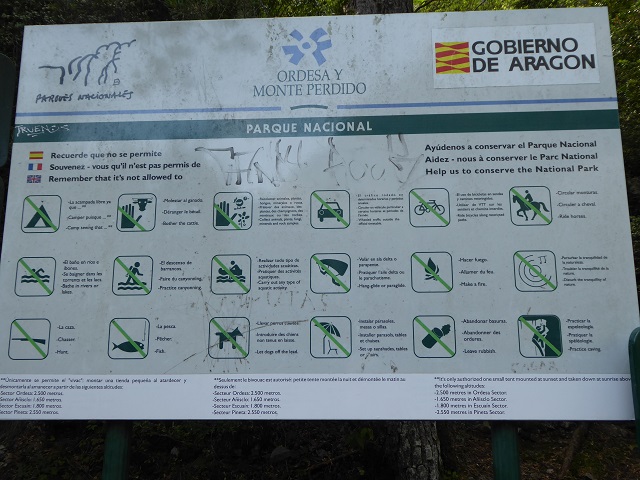 While ostensibly the rules about overnight camping and other activities are very strict in the Pyrenean National Parks and “Parco Natural”, beneath the no camping signs the small print explains how tents can be put up at dusk as long as they are taken down at dawn.
While ostensibly the rules about overnight camping and other activities are very strict in the Pyrenean National Parks and “Parco Natural”, beneath the no camping signs the small print explains how tents can be put up at dusk as long as they are taken down at dawn.
Within these rules camping appears to be supported and facilitated, whether for large organised groups or the general public.
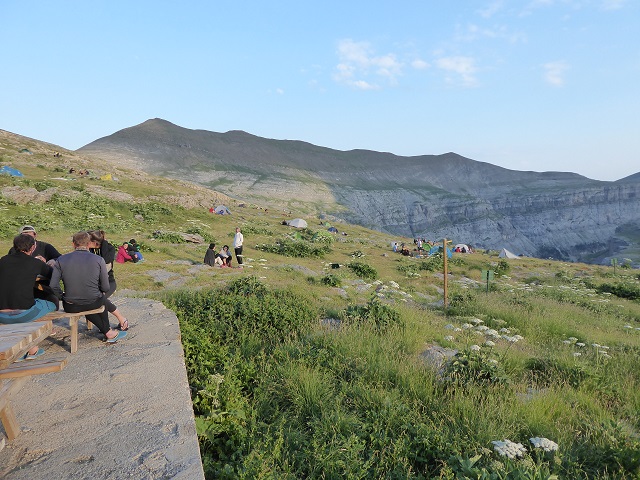
We counted 60 or so tents dotted across the hillside above the Goriz Hut, an area just as sensitive as the loch shores in the Loch Lomond and Trossachs National Park, where the numbers allowed to camp in each permit area are strictly limited and the total number of places outside formal campsites across miles of loch shore is less than 300.
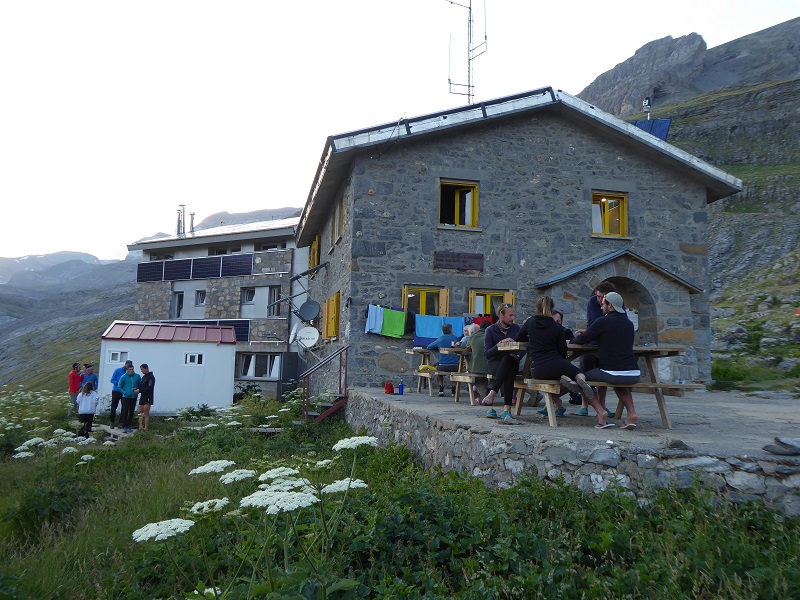
What’s more, while the LLTNPA has been trying to play divide and rule between campers and other visitors, claiming campers impact on other visitors ability to enjoy the area, in Spain it appears all visitors are treated alike. The Goriz Hut, which has limited capacity, has two meal sittings and guess what, many of the campers buy a meal there or a drink from the bar. The hut has an external toilet block for use by campers and has laid on an outside tap to provide water (since the underlying rock is limestone water would otherwise be a problem). The infrastructure of the hut and the way its managed are designed to benefit everyone, not just one group.
While the Loch Lomond and National Park Authority has, as a result of the International Year of Young People, given young people a voice on its Board (see here), this will turn out to be tokenism unless it results in more young people being supported to experience the great outdoors. The Young People involved could learn from places like Spain.
Thank you Nick , What a wonderful report.
The experience witnessed some years ago while touring in New Zealand seems relevent. Just as the peak holiday demand period started, thousands of NZ students appeared and took Holiday “jobs” as volunteers ..with living expenses funded… in the national parks and scenic areas. This added quality to their personal CV’s. These young people carried out maintenance and worked on state funded projects to improve facilities, under full supervision of professional Park Rangers. In Scotland the knowledge within the Park ranger service to oversee such projects is questionable. It requires resources to address the bureaucratic planning “hurdles” and to fund this type of volunteer.
Besides – up till 40 years ago it was easy for student volunteers to get seasonal jobs in outdoor education to boost adult/teenager ratios and enable the safe running of “expeditions” for all ages. The Lyme bay Kayak tragedy in the 1980’s and other failures encouraged a thoroughly litigious culture around those organisations which ran outdoor activities. For over 30 years since, no formal outdoor pursuit organiser dares to recruit the “Unqualified” at all. While holiday activity centres and groups closed down everywhere, instead, a huge UK based commercial “qualification” industry has sprung up, to award training certificates in all outdoor activities. To get effectively qualified costs – lots. !
In the Netherlands Scouting is enormously popular. Locally most Junior scouts become Senior Scouts and then some of them go on to become troop leaders..locally trained in their role and then help run international events. They take part in trips and camps all over Europe.
By contrast in the UK scout groups, local youth activities centres , and too many schools struggle to find enough volunteer adults to assist build correct staffing ratios. Extra curricular activities, the chances for them cease. Hard not to conclude this is partly due to the “state legislated” universal requirement for ACRO database checks, but the cost of staff training is huge. Those who might have helped in earlier times are reluctant to submit themselves to full scrutiny first. By default the UK authorities have raised a generation of young people now told to be “feared”of wild places. They hear that correct ( read ‘expensive’ )safety equipment is required for almost everything TV programs remind them that licences and permits are necessary, and in all things they must always be wary of “well meaning” adults.
Thirty years of this, and today too many young British adults have grown up with absolutely no experience of outdoor leadership. Most younger people and parents were denied much personal experience in easy going outdoor enthusiasms which they could dare share. This is the shame.
Whilst I don’t agree with some of your claims, I do think there’s a general issue in that we (the British) appear to find it easier to think “what if” and invent yet another important rule, rather than think more objectively about “does it matter”. This comes down to risk assessment – not trying to address all risks “just in case”, but first deciding how likely risks are to occur. But to then apply that thinking, folk need to believe that they are trusted and that their decisions will be supported – which comes down to adequate leadership within the organisation. The fact that people “on the ground” don’t take this approach – and are forever inventing knew rules to cover risks that almost never materialise and/or aren’t important – is more down to that lack of leadership. They worry that “they” will be the ones who’ll have to take all the blame “if” something should happen. Leadership starts at the top.
Andrew, Nothing I wrote should be taken except as well informed comment on the state of affairs in UK. There were no ‘claims’. I am interested You “claim” to have issue with some of the content. It would be worthwhile to know which comments I made you take issue with.
Based on over 50 years in and around outdoor pursuits both in the UK and overseas.( A period of several seasons as instructor before “safety first” became institutionalised, a period of several years leading international groups on long duration trips across continents, a period within the forces, and a longer period in recent years, helping like minded enthusiasts to experience self reliance based on local knowledge, during remote holidays in wild places. I also have a son who is a volunteer troop leader within scouting Nederland.
Perhaps the LLTNPA should fund their youth reps to visit places like this – much as you have – and report back on their findings. In fact why don’t they engage directly with these other parks to host such visits (and vice versa). It wouldn’t be expensive and would be a great way to both engage the reps and build learning from elsewhere.
Character building is to be discouraged at all costs, the youth llatnp will choose an environment project.
Walking in the Mountains of Mourne in June this year on holiday from our home in Aberdeen we met several groups of youngsters on 3/4 day hikes participating in the Duke of Edinburgh Award scheme. They were self-supporting and practically everyone was having a good time passing through quite rugged hill country and leaving no trace of their camping or refreshment stops along the way. The weather was good and their daily distance was about 15K but still mentally and physically challenging. Adult leaders were on hand to send them on their way and to meet them at their destination and the groups had a radio to contact assistance and must have been involved in the youngsters’ training for their hikes.
From my experience in the past as a Scout Leader I know how important it is to have adults involved and also how difficult it is to get in particular, young adults to commit to assisting given the necessary training and certification required. However, from my own experience and seeing it in others the ‘job satisfaction’ attained is huge and the sense of achievement in the youngsters is immeasurable. If we want to encourage young folk to go out and enjoy our countryside and enjoy it responsibly we must say not, “something needs to be done” but, “what can I do”